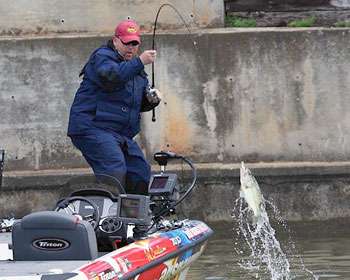
Louisiana pro Jeff Connella knows that the ability to locate fish quickly is the primary difference between top-flight Elite Series pros and many of their weekend angler counterparts. While that is a generally accepted truth, there's a corollary that often goes unspoken — what separates a pro from a truly successful pro is the ability to relocate fish.
It's especially true in the spring, when fish looking to spawn or coming off the spawn may move not just daily, but hourly. And that scenario is further complicated by the fact that intermittent but often heavy rains may cause the lake level to fluctuate greatly. When that happens, and the lake rises overnight, Connella believes that you typically shouldn't waste time fishing the old shoreline.
"They'll move quickly," he says. "Typically when the water comes up real fast the fish go to the bank. Worms come up out of the ground and the bream go up there to feed, so the bass move up there to feed as well. You start off looking in those same pockets where they had been before."
During this year's Elite Series event on Alabama's Lake Wheeler, brutal rainstorms pounded the region, causing the cancellation of a tournament day. When the anglers returned to the water the next day, there was a lot more of it to contend with. Connella had found his fish "in the backs of the creeks on the last piece of wood that I could get a bait to," but quickly learned that the key cover was no longer holding fish. They'd moved even farther back.
There's no universal rule as to whether the fish will stay put, move out or move farther back into a pocket. A lot of that, Connella says, "depends on what type of pocket, if you have a feeder creek in the back of the pocket. It depends on whether you have a warm rain or a cold rain.
"One of the things you need to watch out for in the spring is that you'll get into one of the creeks and you get too far in the back and the water will actually get colder," he continues. "You can have 60 degree water in the front and 54 degree water way in the back. Start working your way out. You want to find the warmest water around."
As long as sight fishing is not his dominant technique, he doesn't shy away from the off-colored water that may arise out of the changing water level. Once in his comfort zone — usually "with visibility of 8 inches or a foot" — he often relies on a Chatterbait-style lure, which he says "is good in that dingier water, especially if most people are throwing a spinnerbait."
But the most important thing of all is to keep an open mind. If the cover or structure that was ultra-productive a few days ago is no longer producing bass, you have to figure out where they went, or else risk a trip to the weigh-in with empty livewells.
"A lot of guys fish memories," Connella says. "They think, 'We caught them here last year or last week — or literally two days ago.' That's OK to start there, but you have to keep moving if they're not biting. The bass will tell you where they are. When you get a bite, you've got a piece of the puzzle. The more bites you get, the more pieces you get, and you'll finally put it all together."
(Provided exclusively to BASS Insider by Z3 Media)





